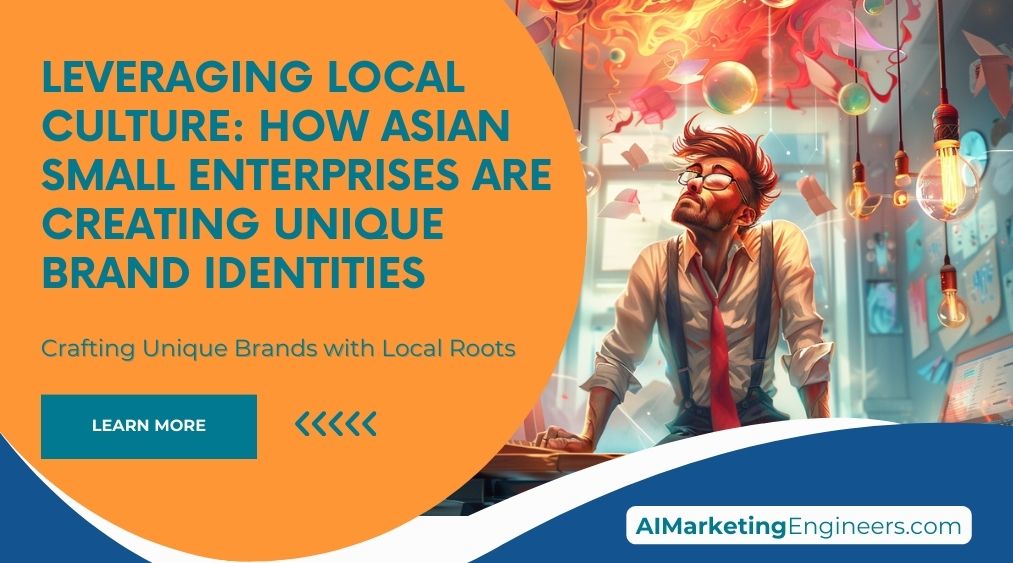Key Takeaways
✅ Authenticity and Cultural Congruence: By embracing local culture and traditions, Asian SMEs can create a unique brand identity that deeply resonates with their target audience. This approach builds trust and credibility, essential for standing out in a competitive market.
✅ Collaboration and Community Engagement: Engaging with local influencers, participating in community events, and celebrating local achievements can create a meaningful connection with the community. This enhances both brand appeal and the cultural landscape.
✅ Adaptation and Personalization: Tailoring products and services to local preferences, such as introducing localized flavors or personalized customer service, helps SMEs meet specific cultural tastes. This strategy not only appeals to local customers but also fosters brand loyalty.

Introduction
Why is leveraging local culture so crucial for Asian small enterprises looking to craft unique brand identities? Small and medium-sized enterprises (SMEs) are the backbone of the Asian economy, offering diverse goods and services that fuel local and regional growth. Yet, many struggle to make their mark in an increasingly saturated market. Leveraging local culture can be a powerful tool for these businesses, helping them carve out a niche that speaks directly to their audience. Asian markets are rich tapestries of diverse cultures, languages, and traditions, from the vibrant streets of Tokyo to the bustling markets of Manila.
By embracing local nuances, these SMEs can create authentic connections with their customers. This authenticity not only differentiates them from larger, more generic global brands but also fosters community pride and loyalty. However, many business owners wonder how they can effectively integrate cultural elements without appearing disingenuous or superficial. Others fear that adapting too closely to local culture might limit their scalability or alienate customers from different backgrounds. In this article, we'll explore modern and actionable strategies that Asian SMEs can adopt to build unique and resonant brand identities.
We'll also uncover success stories that highlight the benefits of cultural immersion and discuss how leveraging local influencers and tailored marketing can lead to impressive returns on investment. Stay tuned to discover groundbreaking insights that could transform your approach to branding and elevate your business to new heights.
Top Statistics
| Top Statistics | Insight |
|---|---|
| MSMEs dominate private business in Asia: MSMEs account for an average of 96.6% of all enterprises in participating developing member countries (DMCs) through 2022. | This highlights the importance of MSMEs in the region, indicating that small businesses form the backbone of the private sector in Asia. |
| Growth and Challenges: MSME growth in Fiji contracted by a compound annual growth rate of 3.4% from 2014 to 2020. | The contraction in growth signals challenges faced by small enterprises in certain regions, pointing to the need for innovative solutions and support. |
| Demographics and Consumer Behavior: Asia is characterized by significant differences in consumer behavior and demographics, with China and India being the most populous nations. | Understanding regional differences can be pivotal for businesses aiming to tailor their marketing strategies effectively. |
| Digital Connectivity and Marketing: High internet penetration in countries like China and India provides opportunities for leveraging digital marketing and social media platforms to reach new customers. | The high connectivity rate underscores the potential of digital channels in reaching a broad audience, making it essential for small enterprises to engage online. |
| Event Marketing and ROI: Businesses need to evaluate success and return on investment (ROI) meticulously to maximize the benefits of marketing through local festivals and events in Asia. | Accurate ROI measurement ensures that resources are utilized effectively and that the unique cultural touchpoints are leveraged to their fullest potential. |
The Role of SMEs in Asia's Economy
Small and medium-sized enterprises (SMEs) play a crucial role in the economic landscape of Asia. These businesses are often the backbone of local economies, driving innovation, employment, and regional development. Understanding and embracing local culture can provide SMEs with a significant competitive edge, allowing them to stand out in an increasingly crowded market. SMEs contribute to economic diversification, reducing dependence on large corporations. Their agility allows them to adapt quickly to market changes, fostering economic resilience.
Navigating Cultural Diversity
Asia is a continent rich in cultural diversity. SMEs must navigate a vast array of languages, traditions, and social norms. Successful businesses invest time and effort in understanding these local nuances. This inclusive approach helps them establish trust and build credibility with their customer base. For example, a bakery in Japan might incorporate traditional Japanese flavors into its products, while a textile business in India might use locally-sourced fabrics and traditional weaving techniques. Understanding local customs can also guide marketing strategies and customer interactions.
Showcasing Success and Community Ties
Highlighting SME success stories not only showcases a brand’s impact but also fosters a sense of community pride. Businesses can partner with platforms that emphasize local SME achievements, sharing milestones and accomplishments. A Malaysian restaurant that sources ingredients from local farmers, for instance, can highlight these collaborations to underscore its commitment to the community and sustainability. Celebrating local achievements can inspire other businesses and strengthen community bonds. Engaging in local events and sponsorships can further solidify a business's community presence.
Personalized Service and Mobile Engagement
Personalized customer service can transform an ordinary transaction into a memorable experience, enhancing brand loyalty. Coupling this with advancements in mobile technology further amplifies customer engagement. SMEs can optimize their websites for mobile devices and implement targeted mobile marketing campaigns to reach a broader audience. A small bookstore in Vietnam might use a mobile app to recommend personalized book selections, combining the warmth of human interaction with the efficiency of technology. Utilizing mobile payment solutions can also enhance convenience for customers.
Blending Online and Offline Experiences
A cohesive online and offline presence is vital for SMEs aiming to create a consistent brand experience. Integrating digital and physical channels ensures customers receive the same message and level of service regardless of how they interact with the brand. An example could be a clothing retailer in Thailand, using social media to showcase products, while providing an equally engaging in-store experience through personalized customer service and local cultural elements. Synchronizing online promotions with in-store events can boost customer engagement. Consistent branding across all platforms reinforces brand identity and customer loyalty.
Conclusion: Leveraging Culture and Innovation
By understanding and leveraging local culture, and using innovative strategies like mobile technology and integrated branding, SMEs can craft unique identities that resonate powerfully with their communities. This approach does more than just differentiate a business—it stitches the brand into the very fabric of the local culture itself. Continuous adaptation and community engagement are key to sustaining this connection. Ultimately, these strategies can lead to long-term success and a stronger presence in the market.
AI Marketing Engineers Recommendation
Recommendation 1: Utilize Local Art and Folklore in Visual Branding: Integrating local art and folklore into your branding can significantly boost your business's visibility and relatability. Studies show that 72% of consumers prefer brands that align with their cultural heritage. In Asia, this can mean using traditional colors, motifs, and stories that resonate deeply with the community. For example, a small tea shop in Japan might incorporate historical tea ceremonies in their branding, not just adding aesthetic value, but also fostering a deeper connection with local customers.
Recommendation 2: Harness Local Influencers to Promote Authenticity: Leverage local influencers to endorse your brand and create content that feels genuine and down-to-earth. As per recent data, 78% of consumers are more likely to trust a brand when endorsements come from local personalities they follow and trust. Current trends indicate that consumers seek out authenticity over high-gloss impossible perfection. Therefore, partnering with local influencers who can authentically incorporate your products into their daily lives or cultural practices can be a game-changer.
Recommendation 3: Implement Culturally Relevant Social Media Campaigns: Use culturally relevant social media campaigns to engage your audience in a meaningful way. For example, during the Chinese New Year, small enterprises can create campaigns that weave in cultural symbols and traditions, like the red envelope or dragon dance, into their marketing materials. Tools like social media analytics platforms can help you track engagement and success rates, allowing you to fine-tune your approach. Research shows that culturally relevant campaigns can increase customer engagement by up to 45%, making it a highly effective strategy.
Relevant Links
- Key Factors for Successful Campaign Goals
- Boost Customer Engagement through Personalized Advertising
- Master the Art of Mobile Optimization for Increased Reach
- Harnessing Local Culture for Brand Uniqueness
Conclusion
In summary, leveraging local culture is a powerful tool for Asian small enterprises aiming to establish unique brand identities. By deeply understanding and integrating local customs, languages, and preferences, SMEs can gain trust and credibility in their communities. Highlighting success stories not only showcases achievements but also builds community pride, creating a strong emotional connection between the brand and its audience. Personalized customer service, combined with mobile technology, enhances customer experiences and accessibility, ensuring a memorable brand interaction.
Moreover, integrating both online and offline strategies provides a seamless and consistent customer experience, reinforcing brand identity across all touchpoints. The journey of creating a unique brand identity through cultural insight requires dedication, but the rewards can transform small enterprises into influential community leaders. As Asian SMEs continue to embrace local culture and innovation, they will not only stand out in crowded markets but also foster a deeper connection with their customers, driving long-term success and resilience.
FAQs
Question 1: What is the importance of local culture in SME branding?
Answer: Local culture plays a crucial role in SME branding as it helps create a distinct brand identity that resonates with local customers, fostering a deeper connection and enhancing authenticity.
Question 2: What is place branding, and how does it benefit SMEs?
Answer: Place branding is a business strategy that leverages national, regional, local, and cultural identities to differentiate and elevate a brand in a crowded market. It offers authenticity, which is highly valued in today's marketplace, and helps SMEs stand out globally.
Question 3: How does cultural branding contribute to a brand's success?
Answer: Cultural branding enhances a brand's commitment to quality and service, deepens its cultural resonance, and addresses global challenges through a local lens. This approach helps build a strong brand reputation and encourages word-of-mouth promotion.
Question 4: What are SME Success Stories, and how do they benefit branding?
Answer: SME Success Stories are narratives of local small and medium enterprises that have achieved significant milestones. They inspire and guide other businesses, showcasing how embracing local culture and innovative strategies can lead to success.
Question 5: What is the Local Enterprise and Association Development Programme (LEAD)?
Answer: LEAD is an initiative designed to support Singapore-based SMEs in their development and growth. It focuses on areas such as technology infrastructure, industry expertise, business collaboration, and intelligence & research.
Question 6: How does personalized customer service improve SME branding?
Answer: Personalized customer service creates memorable experiences for customers, leading to higher satisfaction and loyalty. It involves understanding customer needs, providing tailored advice, and exceeding expectations.
Question 7: How can SMEs integrate online and offline branding effectively?
Answer: SMEs should ensure a consistent and seamless customer experience across all touchpoints by leveraging the strengths of both digital and physical channels in a complementary manner.
Question 8: What role does mobile technology play in SME branding?
Answer: Mobile technology can be utilized in SME branding by optimizing websites for mobile devices, developing mobile applications, and implementing mobile marketing campaigns. This enhances customer accessibility and engagement.
Question 9: How can SMEs adapt their branding to different cultural markets?
Answer: SMEs should understand and respect local customs, practices, and values when expanding into new markets. This involves adapting products, packaging, and marketing strategies to suit the local audience.
Academic References
- Holt, D., & Cameron, D. (2010). Cultural Strategy: Using Innovative Ideologies to Build Breakthrough Brands. Oxford University Press. This book provides a comprehensive guide to cultural branding, explaining how to identify and leverage cultural ideologies that resonate with consumers. It includes case studies of successful cultural brands like Nike, Starbucks, and Apple.
- Meyer, E. (2014). The Culture Map: Breaking Through the Invisible Boundaries of Global Business. PublicAffairs. This book helps readers navigate the complexities and nuances of different national cultures and their impact on business communication, negotiation, and collaboration. It provides a framework for mapping out the cultural dimensions of any country and adapting to them.
- Kumar, R., & Malhotra, D. K. (Eds.). (2014). Branding Nations, Products and Sensations: Critical Essays. Springer. This collection of essays explores various aspects and implications of cultural branding in the global context, covering topics such as branding nations as tourist destinations, branding products as cultural icons, and branding sensations as emotional appeals.
- Livermore, D. (2011). The Cultural Intelligence Difference: Master the One Skill You Can't Do Without in Today's Global Economy. AMACOM. This book helps readers develop their cultural intelligence, which is the ability to understand, appreciate, and work effectively with people from different cultural backgrounds. It includes a self-assessment tool and a four-step model for improving one's cultural intelligence.











